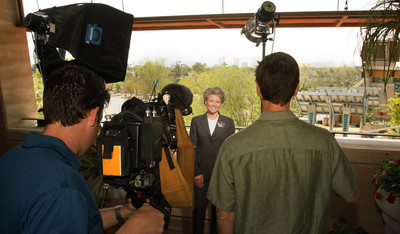Water story makes big splash
The story has everything, from the lights of Las Vegas to the end of the world. No wonder it's drawing so much attention from media worldwide.
Over the past year, the Southern Nevada Water Authority has fielded a barrage of interview requests from media outlets from across the country and around the globe.
They all want to talk about the same thing: doomsday predictions for climate change, drought on the Colorado River and Las Vegas' water future.
Authority officials have been interviewed more than 30 times by some of the world's most recognized publications and broadcast outlets, from Good Morning America to the BBC, Time magazine and the French newspaper Le Monde.
These aren't the usual freelance journalists parachuting in from Los Angeles or New York, either. The world's most widely circulated newspaper, Japan's Yomiuri Shimbun, sent a staffer from Tokyo. The reporter from Le Monde came over from Paris.
The requests really started to pour in two months ago after the Scripps Institution of Oceanography released a report predicting a 50-50 chance that Lake Mead could run dry by 2021.
Within a week, water authority Public Information Manager Scott Huntley had fielded 18 media inquiries.
"It was really a made-for-headline, made-for-TV kind of study," he said.
The onslaught continues.
Earlier this month, water authority General Manager Pat Mulroy taped an interview for CBS News Sunday Morning. On Tuesday, she sat down with the Weather Channel and the English-language branch of the Arabic news network Al Jazeera.
"That was about as exotic a request I've gotten in my career," Huntley said, and he wasn't talking about the Weather Channel.
For Mulroy, who has done the lion's share of the interviews, the surge in interest is proof of just how serious the drought got last year. The Scripps study simply brought the matter into sharper focus, she said.
Huntley said the tone of recent interviews has changed somewhat when it comes to the study.
"We're starting to get into the longer-term follow mode instead of the initial-frenzy mode," he said.
Scripps researchers trace Lake Mead's fall to climate change and overuse of water from the Colorado River. According to the study, there is also a 50 percent chance that the reservoir's level will fall low enough to shut down power generation at Hoover Dam by 2017, and a 10 percent chance the lake could empty by 2014.
Water managers have questioned the study's methodology, but Mulroy said its conclusions about Lake Mead cannot be dismissed out of hand.
"Can I say it is impossible? No, I can't say it's impossible."
International interest in the study, and the Colorado River as a whole, comes as no surprise to Mulroy.
"From a media perspective, it's a sexy story for them. You've got Las Vegas. You've got the Grand Canyon. You've got Los Angeles," she said.
"And climate change is an enormous issue in Europe. It's much bigger there than it is here. They're not arguing about whether it's real or not anymore."
Mulroy got a bizarre, firsthand taste of Europe's fascination with the issue a few weeks ago, when she traveled to Zurich, Switzerland, for a speaking engagement before an environmental think tank, which paid for the trip.
Mulroy said she turned on the television in her hotel room, and a familiar face appeared on the screen: hers. It was video, freshly dubbed in German, from an interview she gave months before in Las Vegas.
"I thought, 'Oh my God, I can't get away from it,' " she said. "It was truly hilarious."
Huntley said the story might not get quite so much traction overseas if it were happening in Portland, Ore.; Sacramento, Calif.; or San Antonio.
"I think Las Vegas has an effect, yes. They can focus on a name they've all heard of. Everybody's heard of Las Vegas."
In February, Yomiuri Shimbun, with its circulation of more than 10 million, published a four-part series on water issues worldwide. Part three was dedicated solely to shrinking Lake Mead and the water authority's turf rebate program.
"There is a real heightened level of attention," Mulroy said.
Reporters aren't the only ones taking notes, either.
Mulroy recently returned from an international water conference hosted by investment house Goldman Sachs in New York City. Both the Scripps study and current conditions on the Colorado River came up at the conference.
Mulroy said it is clear that "Wall Street is watching" the water situation in Las Vegas, something that could impact private investment in, and bond ratings for, projects in the region.
So what did Southern Nevada's water czar say to calm the jangled nerves of the nation's largest investment firms?
"As dire as it looks on television, Las Vegas has a plan," Mulroy said she told them. "Never underestimate Las Vegas' ability to adapt."
The community's plan is to lessen its dependence on the drought-stricken Colorado River by building a pipeline to tap groundwater across eastern Nevada.
The project is expected to stretch 250 miles, as far north as Great Basin National Park, and cost between $2 billion and $3.5 billion.
Even at peak capacity, however, the pipeline would supply fewer than 400,000 homes, far less than what the Colorado River provides. The Las Vegas Valley gets 90 percent of its water from the river by way of Lake Mead.
The Progressive Leadership Alliance of Nevada is one of several groups that have objected publicly to the pipeline project, declaring it a threat to the environment and the livelihoods of rural residents.
PLAN's executive director, Bob Fulkerson, said he welcomes all the media attention, even if it gives water authority officials a larger forum to tout the virtues of their pipeline.
"The spin can work both ways. All eyes are on Las Vegas, and the reporters we have talked to are pretty much aghast that Las Vegas wants to go through with this project."
Contact reporter Henry Brean at hbrean@reviewjournal.com or (702) 383-0350.


















